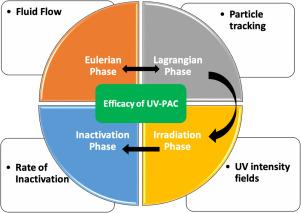利用带拉格朗日跟踪的紫外线空气净化器研究空气中病毒灭活的大涡模拟
IF 2.9
3区 环境科学与生态学
Q2 ENGINEERING, CHEMICAL
引用次数: 0
摘要
为应对最近的COVID-19大流行,紫外线(UV)空气净化器已被推荐为一种缓解策略,以灭活空气中的病毒并减少感染在封闭空间内的传播。本文着重于开发一种高保真度的计算方法来研究这种设备的有效性。大涡流模拟是用来解决湍流内部的净化器与2个紫外线灯激活指定的操作条件。将完全耦合或双向耦合方法与计算效率高的单向耦合方法进行了比较。一旦欧拉流动达到统计收敛,提取时间平均速度和温度分布,并将其提供给欧拉-拉格朗日框架,以基于冻结流动方法检查携带病毒的液滴的湍流扩散。这些模拟结合了病毒液滴的蒸发模型,强调了解释这种物理现象的重要性。大多数从净化器流出的液滴被鉴定为含有非挥发性物质和病毒副本的液滴核。这些排出的携带病毒的飞沫的存活率是用紫外线辐射消毒溶剂确定的,该溶剂是根据现有的实验研究开发和验证的。由此产生的紫外线空气净化器的失活率达到99%,突出了其作为有效缓解策略的潜力。本文章由计算机程序翻译,如有差异,请以英文原文为准。

Large eddy simulations to investigate airborne virus inactivation using a ultraviolet air purifier with Lagrangian tracking
In response to the recent COVID-19 pandemic, Ultraviolet (UV) air purifiers have emerged as a recommended mitigation strategy to deactivate airborne viruses and reduce infection spread within enclosed spaces. This paper focuses on developing a high fidelity computational methodology to investigate the efficacy of such devices. Large Eddy Simulations are used to resolve the turbulent flow inside the purifier with 2 UV lamps activated for specified operating conditions. A fully coupled, or two-way coupling approach, is compared with a computationally efficient one-way coupling method. Once the Eulerian flow reaches statistical convergence, time-averaged velocity and temperature distributions are extracted and provided to an Eulerian–Lagrangian framework to examine the turbulent dispersion of virus-laden droplets based on a frozen flow approach. These simulations incorporate an evaporation model for virus-laden droplets, highlighting the importance of accounting for this physical phenomenon. The majority of droplets exiting the purifier are identified as droplet nuclei containing non-volatile matter and virus copies. The survival rate of these expelled virus-laden droplets is determined using a UV radiation disinfection solver, developed and validated based on existing experimental studies. The resulting inactivation rate of the UV air purifier reaches 99%, highlighting its potential as an effective mitigation strategy.
求助全文
通过发布文献求助,成功后即可免费获取论文全文。
去求助
来源期刊

Journal of Aerosol Science
环境科学-工程:化工
CiteScore
8.80
自引率
8.90%
发文量
127
审稿时长
35 days
期刊介绍:
Founded in 1970, the Journal of Aerosol Science considers itself the prime vehicle for the publication of original work as well as reviews related to fundamental and applied aerosol research, as well as aerosol instrumentation. Its content is directed at scientists working in engineering disciplines, as well as physics, chemistry, and environmental sciences.
The editors welcome submissions of papers describing recent experimental, numerical, and theoretical research related to the following topics:
1. Fundamental Aerosol Science.
2. Applied Aerosol Science.
3. Instrumentation & Measurement Methods.
 求助内容:
求助内容: 应助结果提醒方式:
应助结果提醒方式:


